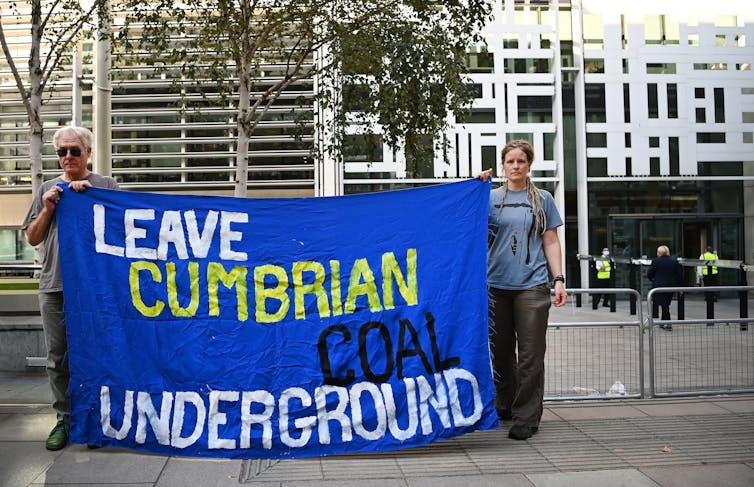A flurry of newspaper articles has speculated that Michael Gove, the UK minister responsible for planning, will shortly approve the long-debated proposal for a new deep coal mine in Cumbria, northern England. Look closer, and this speculation is based on one unnamed source who told The Sunday Telegraph: “I don’t know for certain, but I get the impression he is going to approve it.” Not exactly a firm yes, then.
As a Cumbria resident and a climate governance specialist, I have followed the complex discussions and legal processes on the mine over the past few years. Misinformation has featured strongly, as I have documented. These latest rumours could be genuine – or they could just be a carefully orchestrated campaign by the mine’s supporters, who have now seized on Russia’s war in Ukraine to make a case for domestic coal production.
Before we get to the Russia point, here’s a recap. West Cumbria Mining, backed by venture capital company EMR, first proposed the mine in 2014, and was backed by Cumbria County Council. But the proposals have been stuck in the planning process since then. After the UK parliament passed more stringent carbon targets in 2019, setting in law the goal of net-zero emissions by 2050, questions about the climate effects of the mine mounted.
The Climate Change Committee raised concerns. Two former UK chief scientific advisers, David King and Bob Watson, and even the US climate envoy John Kerry, all criticised the plans. In response, the government took the decision away from the local planning committee and called a public inquiry led by a planning inspector, which took place last autumn. The inspector has now made a recommendation to Michael Gove, but his findings will not be published until Gove makes his final decision.
Need for steel
The case for the mine has always rested on two, linked arguments: that the mine will not result in increases in global carbon emissions, and will therefore not harm the climate; and that the coal is needed for the UK steel industry. On the first point, the evidence is clear. No new coal mines can be built if we are to remain within the globally agreed goal of keeping warming to 1.5°C. This was confirmed in a recent report by the International Energy Agency, and by peer-reviewed scientific research, presented to the public inquiry by world-renowned experts including former UK science chief Bob Watson.
In political debate, much has been made of the second argument, that the mine will provide a domestic source of coal for UK steelworks. But the mining company itself told the public inquiry that nearly all the coal from the mine – around 85% – would be exported, not least because it contains too much sulphur for the UK market. They couldn’t find UK steel companies willing to say that they would use the coal.

Might this have changed, now that Russian aggression has changed the geopolitical landscape? The steel experts I’ve spoken to say not. The war in Russia may provide political cover, but hasn’t changed the fundamentals. The coal has a limited market in the UK. The best thing for energy security and climate stability would be to help the steel industry transition to low-carbon steel, using hydrogen – a proven technology.
The mine that makes no sense
It is my job, as an academic, to assess evidence. I have followed every step of this case over years now, including the weeks-long public inquiry. I have trawled through many pages of detailed documents. My conclusion, shared by the many economists, steel industry experts and climate scientists who contributed to the public inquiry, is that the mine makes no sense for the climate, or for energy security.
Why, then, might it be approved? The truth lies in the complex, ambiguous and contradictory laws in the UK. The country has strong carbon targets, enshrined in the Climate Change Act, yet it is not clear where responsibility for meeting these targets falls. Local government has no statutory responsibilities on climate change, nor does Michael Gove’s own department. In practice, it is far too easy to claim that those targets are someone else’s responsibility.

Planning law, meanwhile, requires consideration of climate change in any planning decision – yet, again, there are no clear rules on how this should be applied to individual decisions, even ones as momentous as a coal mine. As a result, cases like the mine, as well as proposals for fracking sites and oil wells, are played out again and again in the courts. This mess plays right into the hands of powerful economic and political interests, whose tactics have switched from denying climate science to questioning and delaying climate action. At the public inquiry, the mine’s lawyers argued that there were no legal grounds to refuse the mine. But while the law is ambiguous, the science is crystal clear: opening the mine would worsen climate change.
Whether Gove approves the mine or not, we have learned lessons from the Cumbria mine saga. There is an urgent need for clear legislation on fossil fuel extraction, linked to carbon targets – not just coal, but oil and gas as well. Local areas, too, need to be given responsibility to meet climate goals, and the powers and resources to develop local strategies that combine carbon reduction with economic renewal. The potential for green jobs in Cumbria is immense, yet we have been locked in argument over the mine, rather than uniting to build the prosperous, low-carbon future that the area deserves.
Listen to more about Cumbria’s proposed new coal mine, including an interview with Becky Willis, on our Climate Fight podcast series.

